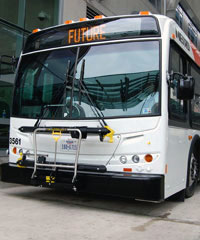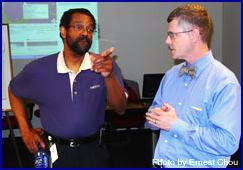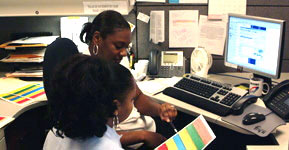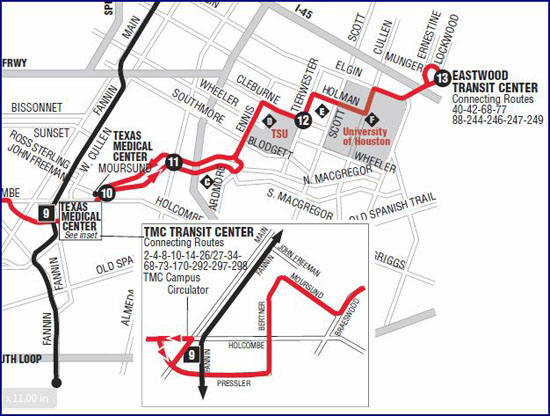Metro
by Andrew Boyd
Today, we leave the car at home. The University of Houston's College of Engineering presents this series about the machines that make our civilization run, and the people whose ingenuity created them.
Security was tight as we entered the facility. I was surprised but, then again, I wasn't. Mass transit systems around the world need to keep up their guard these days.
 I visited the Harris County METRO office along with a small number of students and administrators as part of a "green" project. We'd been asked by officials at the University of Houston to make recommendations about the school's shuttle system. How could the school better coordinate shuttle schedules with those of METRO busses?
I visited the Harris County METRO office along with a small number of students and administrators as part of a "green" project. We'd been asked by officials at the University of Houston to make recommendations about the school's shuttle system. How could the school better coordinate shuttle schedules with those of METRO busses?
The problem's a great example of systems engineering. The goal isn't to build a better mousetrap, but to integrate a collection of mousetraps so they actually catch the mouse. Harris County's the most populous county in Texas, and the third most populous in the nation.  It's home to Houston, and in 2009 boasts just one light rail line.That means busses carry the bulk of passengers — over a quarter million every day. Good planning, scheduling, and operation are crucial to making the system work.
It's home to Houston, and in 2009 boasts just one light rail line.That means busses carry the bulk of passengers — over a quarter million every day. Good planning, scheduling, and operation are crucial to making the system work.
Computers and mathematical models are pervasive at METRO. Planners use the models to decide where busses should run. Schedulers use the models to determine when busses should run — all twelve-hundred of them.
 Beyond scheduled busses, there's METROLift — curb-to-curb shuttle service for the disabled. Every day, hundreds of METROLift busses must be scheduled on the fly. Without computers and mathematical models, METROLift schedulers simply couldn't do their job.
Beyond scheduled busses, there's METROLift — curb-to-curb shuttle service for the disabled. Every day, hundreds of METROLift busses must be scheduled on the fly. Without computers and mathematical models, METROLift schedulers simply couldn't do their job.
There's an old story told about a gambler who drove to Las Vegas in a forty-thousand dollar Jaguar and drove home in a four-hundred-thousand dollar Greyhound. Today things are a lot more expensive. "Busses used to be trucks with seats," said Kurt Luhrsen of METRO. "Now they're million dollar computer systems."

Synchronized onboard clocks keep drivers on schedule. Every few minutes, GPS locators send information about where each bus is. Analysts at headquarters can see how fast a bus is moving, when its doors open and close — even how many people get on and off at each stop. This information can be analyzed and used to provide better service. For example, if enough people get on and off at a particular stop, it signals METRO that a weather shelter should be built.

We learned a lot during our visit to METRO, though nothing came as a surprise. The technology has been around for a while. But I still marvel at the advances we've made in managing transportation systems. Mass transit. Package delivery. Even garbage collection. And the problems just keep getting bigger and more complex. One thing's for sure. The future holds many opportunities for the inventive — and well-trained — mind.
I'm Andy Boyd at the University of Houston, where we're interested in the way inventive minds work.
Special thanks to Michael Leonard, Senior Planner, METROSolutions, for arranging the visit to the METRO Offices. Thanks, too, to the many METRO Staff members who made their time available during our visit, including:
Michael Andrade CTFM, Manager of METROLift Services, Operations
Jose Jaimes, Transit Planner II, Operations Planning
Gregg Konzem, MetroLift Services Operations Supervisor, METROLift
Kurt Luhrsen, Director of Service Planning and Evaluation
University of Houston visitors included:
Robert Browand, Director of Parking and Transportation Services
Stuart Greene, graduate student
Hazem Smadi, graduate student
Harris County, Texas. From the Wikipedia web site: https://en.wikipedia.org/wiki/Harris_County,_Texas. Accessed April 13, 2009.
Travel Modeling 101. From the web site of the Metropolitan Transit Authority of Harris County: http://metrosolutions.org/posted/1068/Modeling_101.132006.pdf. Accessed April 13, 2009.
Pictures are taken from the web site of the Metropolitan Transit Authority of Harris County: http://www.ridemetro.org/Default.aspx. Accessed April 13, 2009.
The METRO lift imge was taken from Wikipedia.